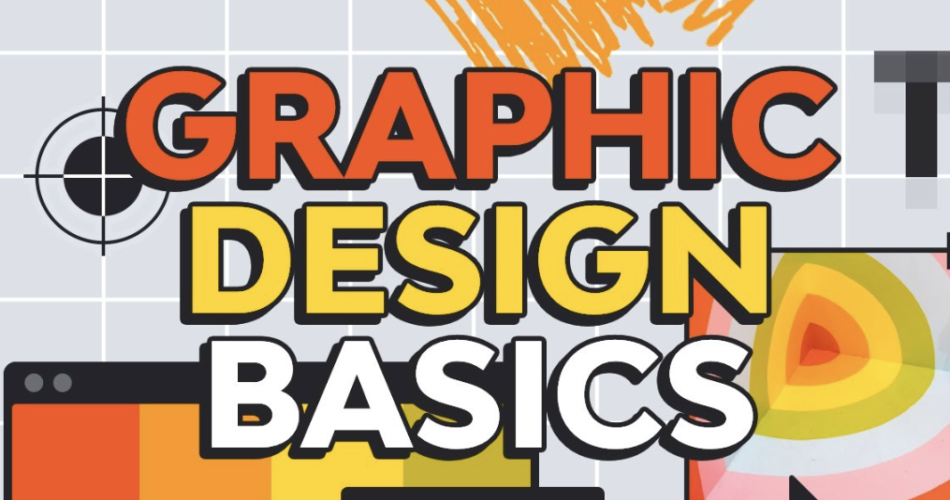Graphic design is a powerful tool for visual communication, enabling individuals and businesses to express their ideas, convey messages, and create captivating aesthetics. It encompasses a wide range of disciplines, including typography, layout, color theory, and image manipulation, all of which work together to craft visually appealing and impactful designs.
In today’s digital landscape, where visual content plays a crucial role in capturing audience attention and standing out in a crowded marketplace, graphic design has become an increasingly sought-after skill. Whether you’re an aspiring designer, an entrepreneur, or a marketing professional, understanding the fundamentals of graphic design can open up a world of opportunities. One of the best ways to develop these skills is by enrolling in graphic design courses, which provide structured learning and hands-on experience.

graphic design courses for beginners
Contents
- 1 Why Graphic Design is Important for Beginners
- 2 Benefits of Taking Graphic Design Courses
- 3 Different Types of Graphic Design Courses for Beginners
- 4 How to Choose the Right Graphic Design Course
- 5 Online vs. Offline Graphic Design Courses
- 6 Top Graphic Design Courses for Beginners
- 7 Tips for Succeeding in a Graphic Design Course
- 8 Resources for Practicing and Improving Graphic Design Skills
- 9 Conclusion
Why Graphic Design is Important for Beginners
For beginners, mastering the art of graphic design can provide numerous benefits. It can help you:
- Enhance Your Communication Skills: Effective graphic design allows you to convey your message more clearly and persuasively, whether you’re creating marketing materials, designing websites, or crafting presentations.
- Boost Your Creativity: Graphic design encourages you to think outside the box, experiment with different styles and techniques, and unlock your creative potential.
- Improve Your Problem-Solving Abilities: Graphic design often involves finding innovative solutions to design challenges, which can enhance your critical thinking and problem-solving skills.
- Increase Your Marketability: In today’s job market, proficiency in graphic design is a highly sought-after skill, making you more attractive to potential employers or clients.
Benefits of Taking Graphic Design Courses
Enrolling in a graphic design course can be a game-changer for beginners. By immersing themselves in structured learning environments, aspiring designers can:
- Develop a Solid Foundation: Graphic design courses provide a comprehensive overview of the fundamental principles, tools, and techniques, laying a strong foundation for further growth and development.
- Learn from Experienced Instructors: Courses often feature experienced designers and industry professionals who can share their expertise, insights, and best practices, accelerating the learning process.
- Gain Practical Experience: Many courses incorporate hands-on projects and assignments, allowing learners to apply their newfound knowledge and receive feedback from instructors and peers.
- Build a Robust Portfolio: Completing a graphic design course can help you create a diverse portfolio of work, showcasing your skills and increasing your chances of securing internships or job opportunities.
- Access to Industry-Standard Tools: Graphic design courses often provide access to industry-standard software and tools, such as Adobe Creative Cloud, equipping learners with the necessary skills to thrive in the field.
Different Types of Graphic Design Courses for Beginners
Aspiring graphic designers have a wide range of course options to choose from, each catering to different learning styles and goals. Some of the most popular types of graphic design courses for beginners include:
- Introductory Courses: These courses cover the fundamentals of graphic design, including the principles of design, color theory, typography, and layout.
- Software-Specific Courses: These courses focus on teaching the use of specific graphic design software, such as Adobe Photoshop, Illustrator, or InDesign, equipping learners with the technical skills to create digital designs.
- Specialized Courses: Learners can explore specialized areas of graphic design, such as web design, motion graphics, or brand identity development, to develop expertise in a particular field.
- Online Courses: With the rise of e-learning, numerous online courses and tutorials are available, offering flexibility and convenience for those with busy schedules.
- Degree Programs: For those seeking a more comprehensive education, universities and colleges offer degree programs in graphic design, providing a deep dive into the theory, history, and practical applications of the field.
How to Choose the Right Graphic Design Course
Selecting the right graphic design course can be a daunting task, but by considering the following factors, you can find the perfect fit:
- Learning Objectives: Determine your specific goals and interests, whether it’s mastering the fundamentals, developing specialized skills, or building a strong portfolio.
- Course Format: Decide whether you prefer an in-person, online, or hybrid learning experience, based on your schedule and learning preferences.
- Instructor Qualifications: Research the instructors’ backgrounds, experience, and teaching methods to ensure they can provide the guidance and support you need.
- Course Content and Curriculum: Review the course syllabus, projects, and assessments to ensure they align with your learning objectives and cover the topics you’re interested in.
- Reputation and Accreditation: Look for courses offered by reputable institutions or online platforms with a proven track record of delivering quality education.
- Cost and Accessibility: Consider the course fees, any additional software or material costs, and whether financial assistance or payment plans are available.
Online vs. Offline Graphic Design Courses
When it comes to graphic design courses, aspiring designers have the option to choose between online and offline (in-person) learning environments. Both formats offer unique advantages:
Online Graphic Design Courses:
- Offer flexibility and convenience, allowing learners to study at their own pace and on their own schedule.
- Provide access to a wider range of courses and instructors, not limited by geographic location.
- Often more affordable, with lower tuition fees and reduced commuting costs.
- Allow for self-paced learning and the ability to revisit course materials as needed.
- Provide opportunities for virtual collaboration and networking with fellow students.
Offline Graphic Design Courses:
- Offer hands-on, in-person instruction and access to specialized equipment and software.
- Facilitate face-to-face interactions with instructors and peers, fostering a more immersive learning experience.
- Provide opportunities for real-time feedback, critiques, and collaborative projects.
- Allow for a more structured learning environment with set schedules and deadlines.
- Offer the potential for internships, mentorship programs, and networking within the local design community.
Ultimately, the choice between online and offline graphic design courses will depend on individual learning preferences, lifestyle, and access to resources. Many learners find success by combining both formats, leveraging the strengths of each to create a well-rounded educational experience.
Top Graphic Design Courses for Beginners
To help aspiring graphic designers get started, here are some of the top graphic design courses for beginners:
- Graphic Design Fundamentals by Coursera: Offered by the California Institute of the Arts, this course provides a comprehensive introduction to the principles of graphic design, including typography, color theory, and layout.
- Graphic Design Specialization by Udemy: This specialization from Udemy covers a wide range of topics, including logo design, branding, and visual identity, with hands-on projects and industry-relevant skills.
- Graphic Design I: Core Concepts by Skillshare: Taught by experienced designers, this course delves into the fundamentals of graphic design, focusing on the creative process, design principles, and software skills.
- Introduction to Graphic Design by Skillshare: This course is designed for complete beginners, offering a gentle and accessible exploration of the basic elements and principles of graphic design.
- Graphic Design Bootcamp by Udemy: For those seeking a more intensive learning experience, this bootcamp-style course covers a wide range of graphic design topics, from branding to web design, with a focus on practical application.
- Graphic Design Specialization by Coursera: Offered by the University of Colorado Boulder, this specialization provides a comprehensive education in graphic design, covering topics such as typography, layout, and visual communication.
- Graphic Design Masterclass by Udemy: This course is a deep dive into the world of graphic design, covering advanced techniques, industry trends, and portfolio development.
Tips for Succeeding in a Graphic Design Course
To maximize your success in a graphic design course, consider the following tips:
- Embrace an Iterative Process: Graphic design is an iterative process, so be prepared to experiment, explore, and refine your work based on feedback and critique.
- Develop a Curious Mindset: Stay curious and open-minded, constantly seeking inspiration from various sources and exploring new techniques and styles.
- Practice, Practice, Practice: Consistent practice is key to improving your skills, so dedicate time to hands-on projects and personal design explorations.
- Seek Feedback and Critique: Welcome feedback from instructors, peers, and industry professionals, as it can provide valuable insights and help you grow as a designer.
- Stay Organized and Manage Your Time: Effective time management and organization are essential, especially when juggling multiple projects and deadlines.
- Immerse Yourself in the Design Community: Engage with the design community through online forums, social media, and local events to stay inspired and network with fellow designers.
- Continuously Learn and Adapt: The field of graphic design is constantly evolving, so commit to lifelong learning and be willing to adapt to new trends, technologies, and industry demands.
Resources for Practicing and Improving Graphic Design Skills
To complement your graphic design course and continue honing your skills, consider exploring the following resources:
- Design Blogs and Magazines: Stay up-to-date with industry trends and best practices by reading design-focused blogs and magazines, such as Smashing Magazine, Creative Bloq, and Graphic Design USA.
- Online Tutorials and Workshops: Utilize platforms like Skillshare, Udemy, and YouTube to access a wealth of free and paid tutorials, workshops, and masterclasses on various graphic design topics.
- Design Inspiration Websites: Explore websites like Behance, Dribbble, and Pinterest to discover and draw inspiration from the work of talented designers around the world.
- Design Communities and Forums: Engage with the design community by participating in online forums, such as r/graphic_design on Reddit, to connect with fellow designers, ask questions, and receive feedback.
- Design Books and Publications: Invest in design-related books, such as “The Design of Everyday Things” by Don Norman or “Graphic Design: The New Basics” by Ellen Lupton, to deepen your understanding of design principles and theories.
- Design Software Tutorials: Familiarize yourself with industry-standard design software, such as Adobe Creative Cloud, by exploring tutorials and documentation provided by the software vendors.
- Design Challenges and Competitions: Participate in design challenges and competitions to push your skills, receive feedback, and potentially earn recognition within the design community.
Ready to take your graphic design skills to the next level? Explore our curated list of top-rated graphic design courses and unlock your creative potential. Click here to get started.
Conclusion
Mastering the art of graphic design is a rewarding and fulfilling journey, one that can open up countless opportunities for personal and professional growth. By investing in high-quality graphic design courses, aspiring designers can develop a solid foundation, acquire industry-relevant skills, and build a portfolio that showcases their talent and creativity.
Whether you’re a complete beginner or looking to refine your existing skills, the wealth of graphic design courses available today provides a diverse range of options to cater to your learning preferences and goals. By following the tips and resources outlined in this guide, you can embark on your graphic design journey with confidence and set yourself up for success in this dynamic and ever-evolving field.
